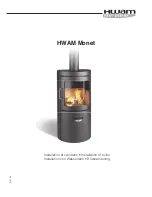
HAMWORTHY HEATING LTD
23
PUREWELL VariHeat he
500001155/F
Figure 8.5.2.4.1- Dividing cascade power over 3 boilers
8.5.2.4
Managing the Cascade
The cascade divides the power over all identical connected boilers by programming the Master with the following
information:
•
Actual power that the cascade needs based upon the Outside temperature and desired heat curve (when
an outside sensor is connected), and the User temperature setting for the thermostat input.
•
Maximum Power (P
max
) that each boiler connected to the cascade can provide.
•
Switching Up Power (P
up
) determines when the next boiler should be turned on if the other boilers run at
this power or higher.
•
Switching Down Power (P
down
) determines when the last boiler should be turned off if all boilers run at this
power or less.
•
Minimum Power (P
min
) that each boiler connected to the cascade, can at least provide.
•
Time delay switching on & off a boiler.
8.5.2.4.1
Example of 3 boiler cascade
When there is a demand for heat, the first boiler ignites and provides as much power as the cascade demands.
When the cascade power increases to a point above P
up,
the next boiler ignites and the total cascade power is
divided between the firing boilers. When all boilers in the cascade are on and the cascade power increases more,
all boilers will provide more power until they reach their maximum outputs. When the cascade power decreases,
and the power of each boiler becomes less than P
down
, then the last boiler switched on is switched off and the
power divided between the firing boilers - see figure 8.5.2.4.1
8.5.2.4.2
Boiler switching On/Off
The description above is theoretical as when a boiler is switched on and the new divided power for firing boilers is
set below P
down
, it is unacceptable that a boiler is switched off immediately. Therefore to correct this, the divided
power should be higher than P
down
, before a boiler is switched off when the divided power is less than P
down
.
However, if the divided power won’t increase until it reaches P
down
, the total power of the cascade will decrease, a
boiler will be switched off as soon as the divided power reaches P
min.
Similarly,if a boiler is switched off and the
new divided power is less than P
up
,it would be unacceptable for a boiler to switch on immediately. Therefore to
correct this, the divided power should be less than P
up
before another boiler is turned on. If however the divided
power reaches P
max
, the next boiler should be turned on.
For example
- suppose:
P
max
= 100%, P
up
= 80%, P
down
= 60%, P
min
= 50%. One boiler is on and the power needed
by the cascade is increasing.
As soon as the divided power reaches 80% the next boiler may be switched on, but it won’t,
because the new divided power will be less than P
min
. 1 boiler on 80% = 2 boilers on 40%
(<50%) In this case the divided power will rise until P
max
, before the second boiler ignites.
1 boiler on 100% = 2 boilers on 50%. When in this example P
down
= 60%, the first boiler will
stay on 100% and the second boiler would switch on as soon as the total power reaches
120%
(2
*
P
min
).
Содержание PUREWELL VariHeat he
Страница 58: ...HAMWORTHY HEATING LTD 53 PUREWELL VariHeat he 500001155 F NOTES...
Страница 61: ...Notes...
















































